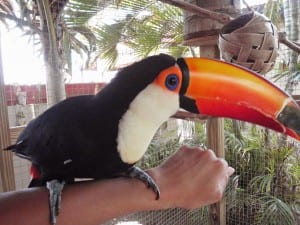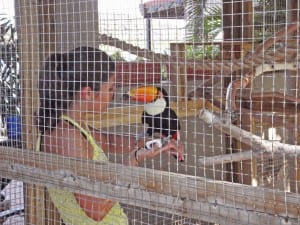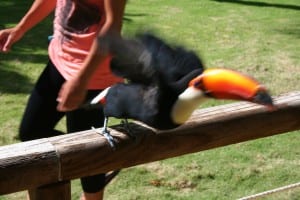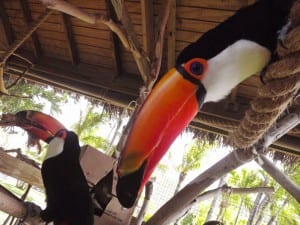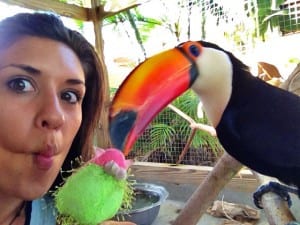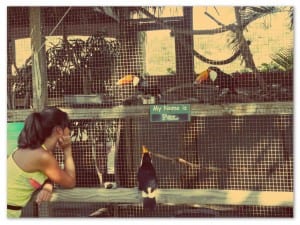Recently, I experienced one of my top training highs since we adopted the Three-Cans. One special morning, the stars aligned and I was given a major reward for my efforts over the past year – all three of the Cans, one right after another, willingly stepped onto my arm in our morning training session. I was finally able to hold not just Paco, but Pepe, and even Paz too. It’s difficult to select the words to properly define the distinct joy that I experienced but here’s a few: elated, blissful, ecstatic, jubilant, gleeful, overjoyed, proud, enlivened… I could go on (this girl’s a word nerd), but I’m assuming you get the picture.
Though as awesome as this success truly is, if you’re like me, I’m sure you’re wondering why it took so long (over a year, in fact) to reach this milestone. Shouldn’t I have been able to handle them months, perhaps even a year, ago? If I do a couple of training sessions each day, what on earth am I training anyway? In the spirit of learning, I thought I’d take a moment to assess my progress and share the factors that, I believe, contributed to the timing of my current success.
Figuring Out My Birds
It has taken me time to understand my birds and I am still learning more each day about what makes them tick – what makes them fearful, what breaks their trust, how far I can push them without pushing them away, what rewards are the best motivators for each bird – a lot of these change, too, with time. Learning how to interpret their body language and their own individual quirks from a past I do not know has been imperative. I have also figured out how to gauge when they are most receptive to training and when it would be a waste of time to even try. I have certainly had my share of futile training sessions due to making the cardinal mistake of training when I decide to schedule it, rather than when my birds are actually in the mood. I have learned to be more malleable and go with the flow so that when they seem eager to interact with me, I can capitalize on those random moments for more effective training sessions.
Toucans are Toucans
I hesitate to pull the toucan card for fear of it sounding like a whiny excuse, but here it is. I do believe the fact that Paco, Paz, and Pepe are toucans, not parrots, has made a difference in the amount of time it takes to obtain the results I am striving for. For one, all of the bird training programs I can find are directed towards parrots. While many of the techniques and concepts are applicable to toucans as well, there are still plenty of things that you must tweak and make your own creative adjustments to for them to be suitable for a toucan. There are also behavioral differences with toucans that work against you in training: they are bouncy, extremely high-energy, and easily distractible – much like I imagine an ADD 2 year old to be. David also likes to say that they’re part cat, as they aren’t that eager to please and definitely operate on their own timeline and agenda, often not participating because they simply don’t care and would rather do something else.
Lots of Time Devoted to Paco
I focused a great majority of my training energy on Paco, especially in the beginning. I would still conduct training sessions with Paz and Pepe but due to their more timid nature, it was mostly all trust building, moving slowly as not to push them too far. I found early on that Paco was much more tolerant and forgiving of my rookie mistakes than the other two, so I think it was wise to get my experience with him first. He also craved more attention, which allowed me to center most of the extra time we were spending together on training pursuits. While this may have slowed down progress with Paz and Pepe initially, I feel it has allowed for more successes now in the sense that when I work with them, I am a much more experienced toucan trainer and make fewer gaffs that would lead to frustrating setbacks with them.
Environmental Changes
Paz and Pepe’s journey from living separately into cohabiting as a breeding pair has also contributed to my moderated training progress with them. Between socializing them, embarking on our first mating season together, three failed clutches, a separation, and now a reunion – training has often times had to take the back burner. Training is an important and positive aspect of their care and well-being, however, when mama’s got eggs in the nest, she cares about little else. And if you get in the way, there’s a good chance you will get bitten (speaking from experience. on the nose. ouch.).
Improving as a Trainer
Having never trained (let alone interacted with) a toucan before adopting the Cans, I was definitely a newbie with a lot of room for growth. It’s been quite the year. While I stress my perfectionist butt out a bit more than is necessary, I thankfully have much to celebrate by way of training successes. I am a better trainer today than I was a year ago. I am still no expert, but between trial and error and by retaining a student’s attitude in the subject of all things bird, I plan to be a better trainer next year than I am today. I now make fewer mistakes that break trust, have fewer setbacks, and in turn, instill greater confidence in the birds in me. I definitely still experience setbacks that, often times, I am not sure of what caused them – but as I continue to observe and learn, I imagine those too will decrease.
A big part of me sharing my experiences is to hopefully show that when you adopt a bird, you shouldn’t give up too soon just because you don’t achieve monumental success straight out of the gates. It takes time and consistent effort to bond and build trust. You need time for individual barriers to break down of their own volition before you can move to the next level. Because my birds arrived to me from a less-than-perfect situation, it was my job to teach them that I was different and that I was going to offer them the respect they deserve, but may not have received from other humans in their past. I continue to reap the rewards of my efforts both large and small. By recognizing them, it helps me to grow and prevents discouragement in times when progress seems slow.
For me, the best road to take is to maintain a constant state of learning. By re-watching and re-reading training materials I found early on, I catch new tidbits that are more applicable to me now that lead to new breakthroughs. I’m also looking forward to the knowledge to come from new training materials on their way (One Day Miracles – can’t wait!), as well as other exciting opportunities ahead that I look forward to sharing more with you such as the Natural Encounters Companion Parrot Behavior Workshop I’ll be attending in February.
Training animals as intelligent as the Three-Cans can be challenging, but that’s what makes it fun. Every moment I have spent has been worth it – better for them, better for me, better for us.

